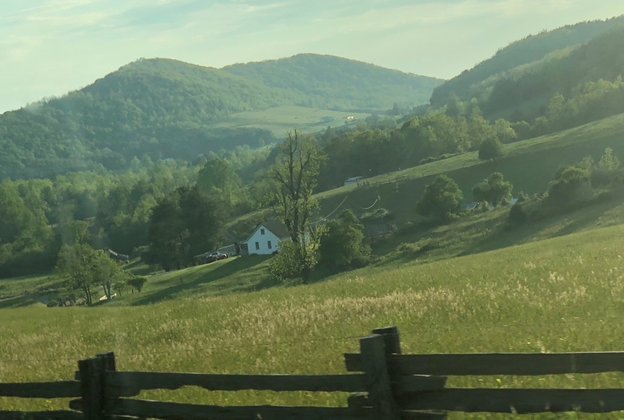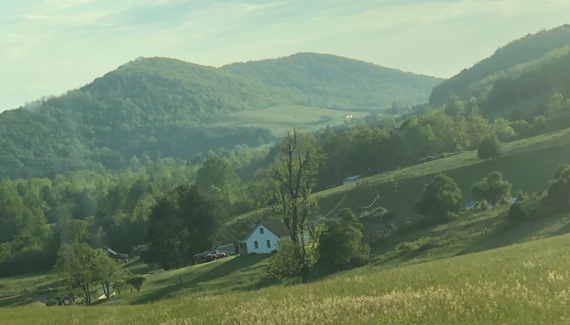
“…we all hate generalities, and so does place.” —Eudora Welty
Assistant Editor Michael Alessi: This summer, for the first time in over two years, I find myself at home again in the Shenandoah Valley and the Blue Ridge Mountains of Southwest Virginia. Seeing the family and friends I’ve been cut off from by the pandemic and a move to the Midwest, I feel caught in the pull of this place that has come to define my personal history and writing, a gravity so strong that it makes my long absence seem like a spell of rudderless drifting. All this is to say, being back in Appalachia, with its landscape of doglegged switchbacks, seesawing ridgelines, and the hollow-filled hills Chris Offutt once described as “humped like a kicked rug,” has pushed me to reflect on the centrality of place in my writing, and engage in the sort of “field work” Associate Editor Connor Yeck wrote about in his blog post about wandering.
Connor points out that the poet Brian Teare has a great approach to the concept of wandering, wherein the objective “is not simply to observe details for later use but to become immersed in a larger landscape that’s both human and inhuman, a process in which a ‘sense of self disappears.’” After time away, my task seems more urgent, amplified by the lingering sense that the ancientness of the mountains, which are literally older than the first trees, might harbor some answer for what roots me in the world; scrawled on the inside cover of my writing journal is a quote from a Breece D’J Pancake letter to his mother, written while he was studying in Charlottesville: “I like to think that I have left my ghost up one of those hollows, and I’ll never really be able to leave for good until I find it. And I don’t want to look for it, because I might find it and have to leave.”
Eudora Welty also advocates for a devotion to setting, arguing in her essay “Place in Fiction” that it’s often taken for granted, despite its crucial role in deepening our narratives and determining the “realness” of our writing: “Being shown how to locate, to place, any account is what does most toward making us believe it, not merely allowing us to, may the account be the facts or a lie; and that is where place in fiction [and I would include in memoir] comes in. Fiction is a lie. Never in its inside thought, always in its outside dress.” To give place its proper due as an essential—if not the most essential—piece of fiction’s “outside dress,” we must write against the generalities and stereotypes that, in the case of regions like Appalachia, are numerous and persistent.
When we write about place well, whether in poetry or prose, readers and critics will often describe the setting as operating like its own dramatic character, as if it possesses a personality and atmosphere that shapes everyone and everything attached to it, almost fatalistically. These kinds of descriptions can feel both persistent and fraught in writing about Appalachia, whose political boundaries drawn by the Appalachian Regional Commission in 1965 still exist, boundaries that Kathryn Trauth Taylor argues in her article “Naming Affrilachia: Toward Rhetorical Ecologies of Identity Performance in Appalachia” are “mythical boundaries that don’t accommodate the nuances of self- and regional-identification with Appalachian culture or the region’s vast history of out-migration.”
In truth, even the term Appalachian isn’t widely used by most who live in the range of mountains extending from the northeast corner of Mississippi to southern New York, just omitting Cincinnati on its western border (though the city itself is still home to a large urban Appalachian population, many of whom still deal with the cost of migration); more common terms include country, hill people, mountain folk, or mountaineers. Despite these nuances and thanks in part to the work of early local-color writers who created many of the region’s most persistent stereotypes, Appalachia has existed for much of its history as an “imagined country,” a colony separate from the rest of America, in conditions too often depicted as exclusively poor and white, as if these are solely the byproducts of its isolated geography and not the result of a long, complex history of outside intervention by industries and governmental agencies. The making of Appalachia thus stands as an example of literary invention and a testament of the power that writing about place can have on our sense of the “realness” of the world.
The history of writing about Appalachia also demonstrates how place-based writing can be restorative. Though the region might have originally emerged as an imagined community in the hands of outside authors, the rise of local voices in the Appalchian studies movement of the 1970s, influenced by the civil rights movement and similar initiatives by women, Native Americans, and other marginalized groups, helped to challenge popularized narratives, providing a more accurate image of the place and its people. Today, Appalachianness is a dynamic and ever-evolving negotiation of the common traditions and markers those with ties to the region claim as their own. As Frank X Walker declares in his poem “Affrilachia”:
A mutual appreciation
for fresh greens
and cornbread
an almost heroic notion
of family
makes us kinfolk
somehow.
Contemporary Appalachian writing also promotes conservation of the region’s wildlife; one great example is “Natural Resources,” a remarkable piece of flash-fiction from Matthew Neill Null’s Allegheny Front (Sarabande, 2016) that I use to teach students how the markers of place can serve as the central focus of a story. Using techniques that eschew human characters, traditional perspective, scenes, and dialogue, Null charts the rise and fall of a local black-bear population in rural West Virginia following the passing and eventual rollback of protective legislation. In his afterward, Null explains his focus on setting and language as an attempt to “let something else be the focal point. An exploding star. Another species. A changing earth. [. . .] The lives of animals are mysterious. Mystery is the lifeblood of fiction.”
Perhaps it is this preservation of abiding mystery that marks the very best writing about place, Appalachian or otherwise. A belief in the irreducible. The human characters of Null’s story may be poor stewards of the place they call home, but in following his example of writing about what can’t be generalized or easily dismissed about setting, we might yet glimpse the ways in which we belong.











